Siding Reno—What to know before purchasing a particular material?
By Editorial Team
Updated on June 13, 2025

A house’s exterior siding or cladding plays a crucial part in its durability and overall appearance. It’s not solely a question of aesthetics; it’s the perfect shield against all weather-caused deterioration, including rainfall, wind, and sun. A decent siding can improve your home’s thermal insulation, reduce energy bills, and increase property value.
What siding materials are best suited to your needs? What are the key steps to installation success? How to properly maintain siding to extend its service life? This article explores said topics and gives you a general idea of option-based pricing.
Whether you’re planning home improvements or building a new house, understanding these aspects will help you make well-informed decisions to protect and add value to your real estate investment.
What is exterior siding on a house?
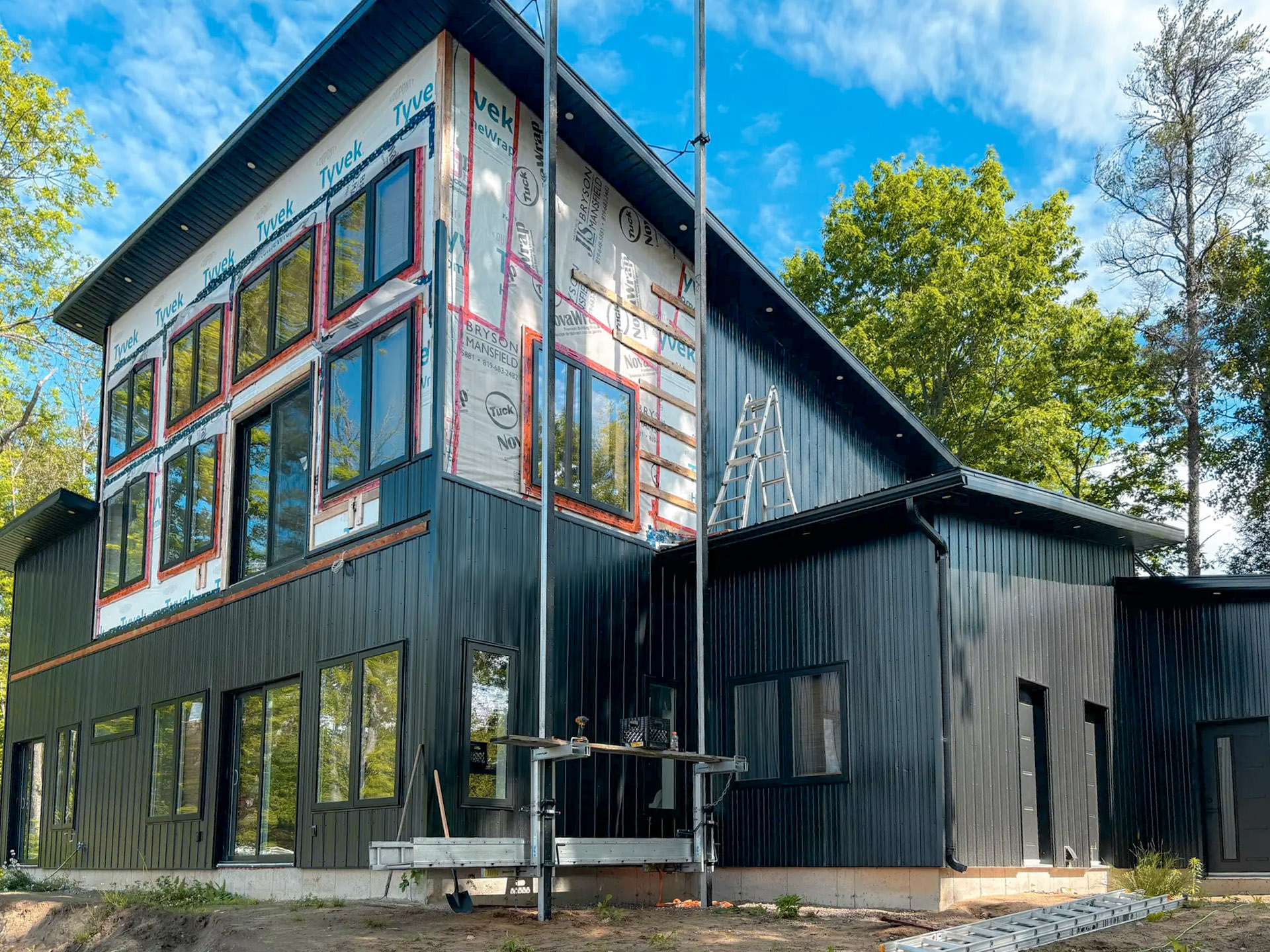
Source : Groupe Boisvert Construction Inc.
Exterior siding is considered your home’s protective envelope, serving as the first line of defence against natural elements, such as rain, wind, and UV rays.
Beyond its protective function, it plays a crucial part in your property’s aesthetic appeal and value. By opting for a versatile construction material for your siding, not only are you extending your home’s lifespan but you’re also improving its look, increasing its curb appeal and real estate value.
Why install exterior siding on your house?
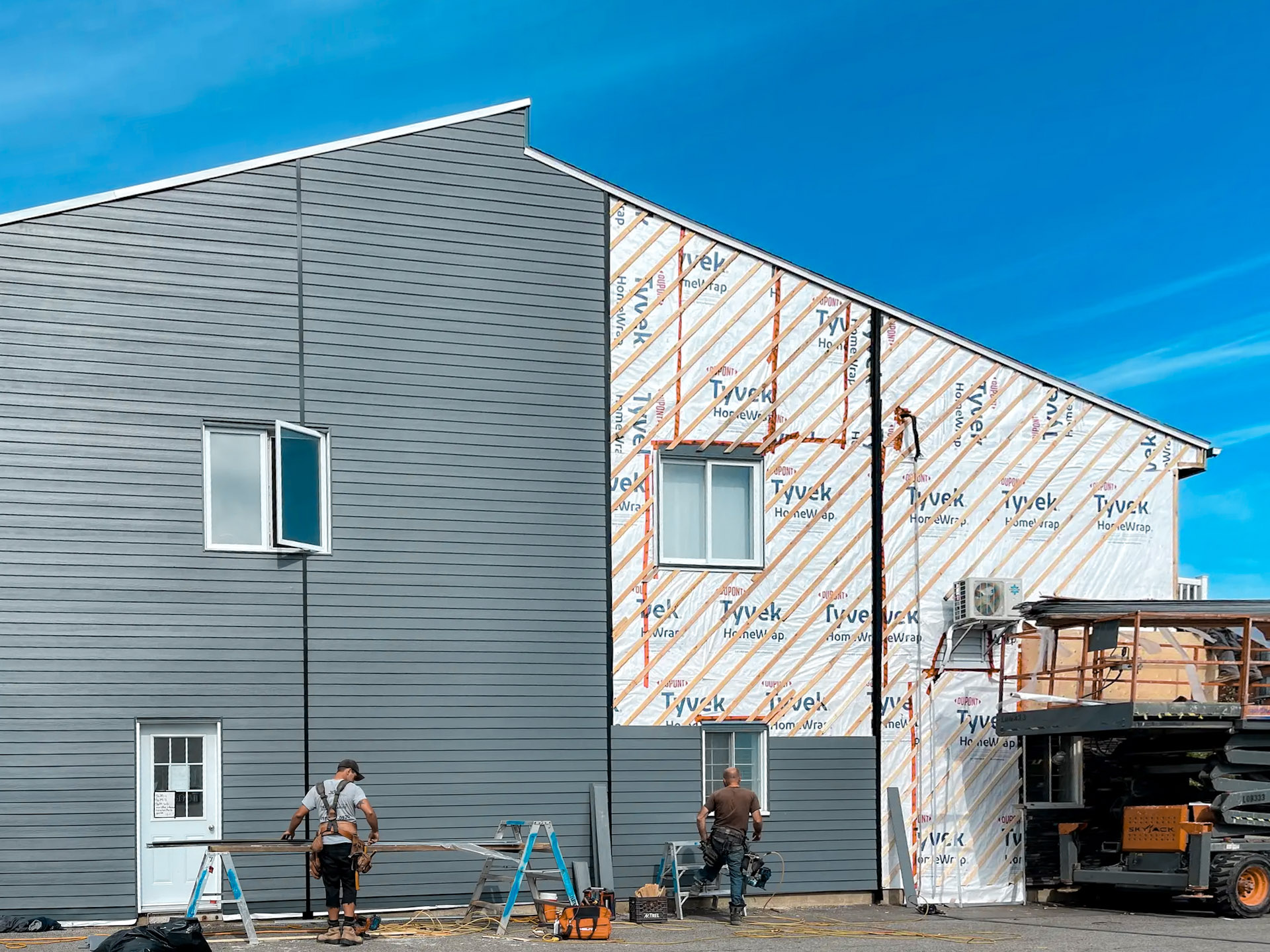
Source : J.L.A. Construction Inc.
Advantages of Good Exterior Siding
Weatherproof
Decent exterior siding, such as engineered wood or fibre cement panels, effectively shields from rain, wind, and UV rays. These materials were designed to prevent water intrusion and provide superior resistance to harsh weather conditions, ensuring your home’s longevity.
Improved Thermal Insulation
Exterior siding is key to thermal insulation. Materials like fibre cement panels or steel cladding are known for their resilient designs and capacity to limit heat loss, contributing to energy savings and better indoor comfort.
Property Value
Choosing the right type of siding or cladding—one suited to your home’s architectural style—can significantly increase the value of your property. By improving the look of your home, you are, in turn, boosting its real estate market appeal, which can translate into a better selling price.
Drawbacks to Consider
Despite the numerous advantages, purchasing exterior siding is a substantial investment, especially if you select materials like stone or brick. Moreover, repairs might be needed, which incur additional costs. As such, carefully planning your budget is crucial, as is choosing a material that suits your needs and environment to limit drawbacks.
What materials are best used for siding outside?
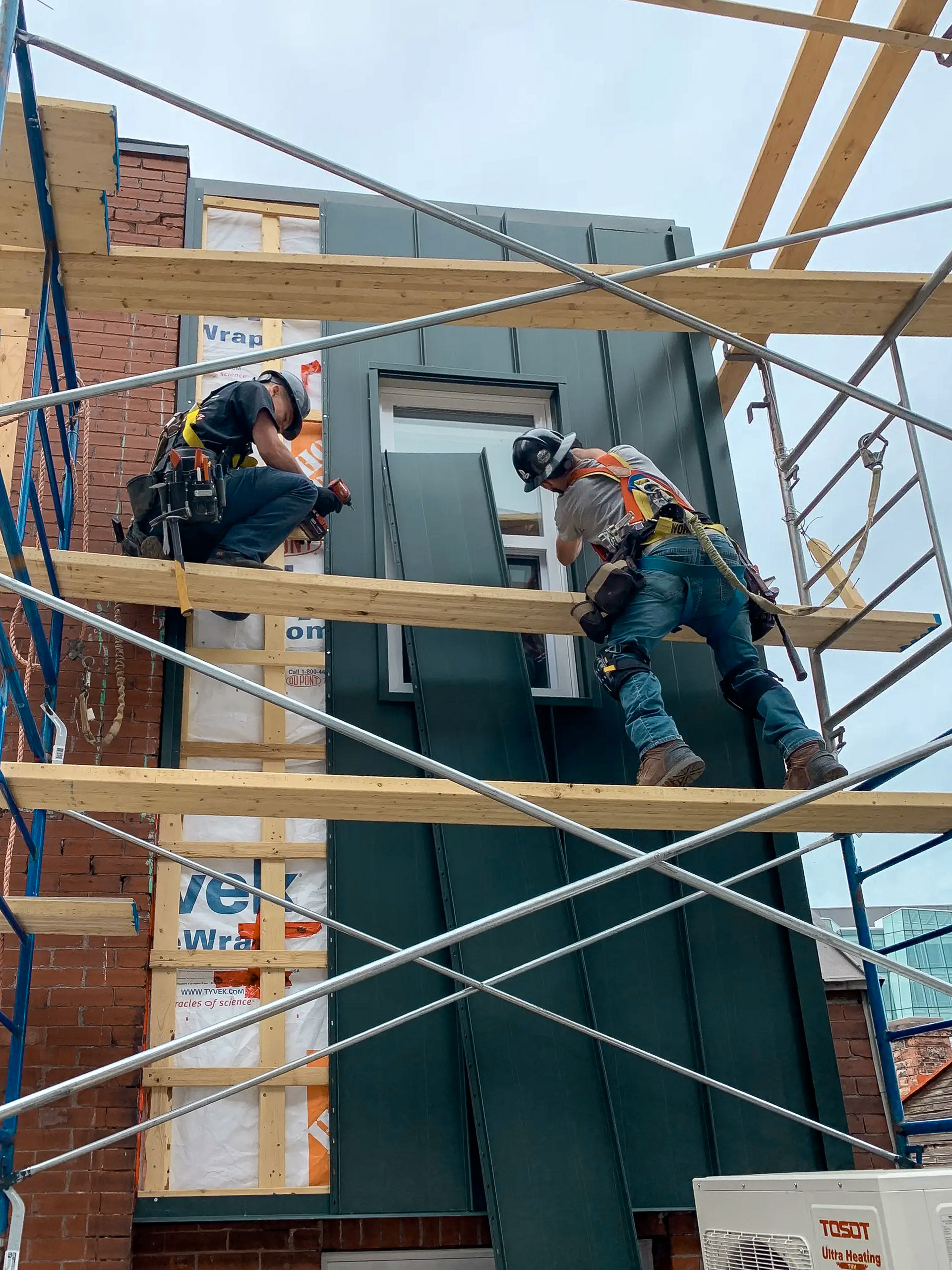
Source : J.L.A. Construction Inc.
Installing your home’s exterior siding means choosing materials that are suited to your needs and aesthetic preferences. All materials have unique characteristics in terms of durability, cost, and look, and understanding everything is paramount to making a well-informed decision.
Available Materials for Exterior Siding
Wood
In terms of architectural look, wood siding is valued for its natural charm and versatility. However, it does require regular upkeep, such as applying a fresh coat of paint or stain to prevent humidity- or UV ray-caused damage. Although cozy and aesthetic, such a material is a lot more high maintenance compared to other options.
Vinyl
Vinyl siding is still one of the most popular picks due to its affordable price point and low maintenance. Available in a broad range of colours and styles, vinyl is a cost-effective solution, albeit less durable compared to more robust materials, such as brick and fibre cement.
CanExel
Made with engineered wood, CanExel siding fuses the natural look of wood with improved weather resistance. This sustainable product requires little maintenance and makes for the ideal option for those looking to balance aesthetics with durability. CanExel is a patented product known for its quality and longevity.
Fibre Cement
Fibre cement is a sustainable composite material that fuses weather resistance and aesthetics. Often used to mimic the appearance of wood or stone, it requires little maintenance and withstands harsh weather conditions, making it a top choice for houses located in regions exposed to harsher weather patterns.
Aluminum
Lightweight, durable, and corrosion-resistant, aluminum siding is often used for commercial and residential building facades. This material is also eco-friendly as it’s entirely recyclable. It’s suited to humid or salt-laden environments on account of its excellent rust resistance.
Stone and Brick
Stone veneer and brick cladding offer unmatched robusticity and a timeless aesthetic. Stone, while expensive, ensures exceptional longevity and minimal maintenance. As for brick, it’s low maintenance, but the mortar joints have to be checked regularly to prevent water intrusion and cracks.
Material-Specific Advantages and Drawbacks
Every exterior siding or cladding material has its share of upsides and drawbacks. See below.
Material | Advantages | Drawbacks |
|---|---|---|
Wood | Natural-looking aesthetic, cozy | Needs regular upkeep (paint, waterproofing treatment) |
Vinyl | Affordable, low-maintenance | Less durable, may fade over time |
CanExel | Moisture-resistant and low-maintenance | Expensive, requires a meticulous installation |
Fibre cement | Very durable, weather- and parasite-resistant | Mid-range prices, may require minor repairs |
Aluminum | Corrosion-resistant, lightweight | Less impact-resistant, may scratch easily |
Stone | High-end aesthetic and durable | Costly price point, complex installation |
Brick | Exceptional longevity and low-maintenance | Expensive prices, mortar joints may need some repairing over time |
How to Install Exterior Siding
Installing exterior siding calls for expert skills to guarantee a proper, durable setup. It’s crucial to follow the manufacturer’s instructions and use the appropriate tools. Installation mistakes can lead to water intrusion problems and reduce the siding’s lifespan. For those who aren’t comfortable with this sort of endeavour, it’s best to hire a good contractor specializing in exterior siding installation.
How much does it cost to re-install siding on a house?
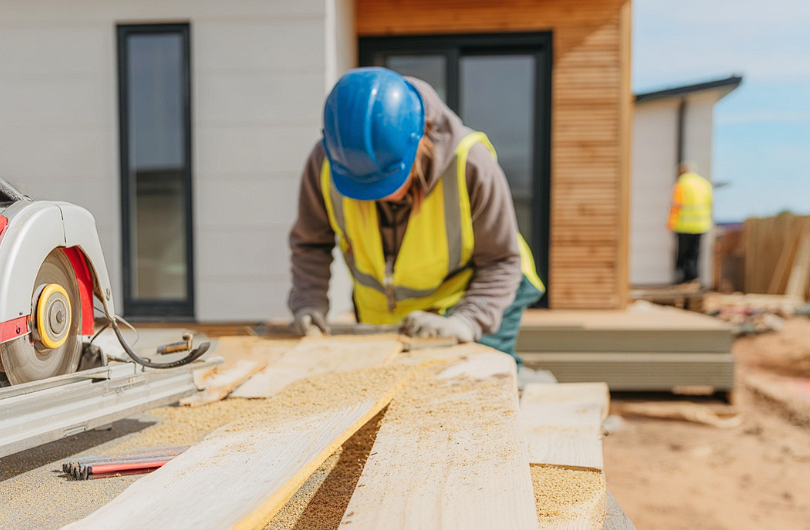
Source : RenoQuotes
The cost of replacing the exterior siding on your house can vary significantly based on the materials selected, the size of the house, and the installation complexity. Properly planning and understanding the different cost-affecting factors is essential to prevent unforeseen setbacks. Here’s a look at the average siding material cost for products available in Canada. It’s also important to choose a material that’s suited to your geographical location and weather patterns to guarantee the product’s durability and efficiency over time.
Material-Based Cost Estimate
Exterior siding materials are quite wide-ranging when it comes to cost.
Material | Cost |
|---|---|
Wood | $10–$15/sq. ft. |
Vinyl | $4–$7/sq. ft. |
CanExel | $6–$15/sq. ft. |
Fibre cement | $5–$15/sq. ft. |
Aluminum | $7–$10/sq. ft. |
Stone | $25–$45/sq. ft. |
Brick | $25–$45/sq. ft. |
Material Cost Comparison
It’s important to compare the different material price points, considering not only upfront costs but also durability and long-term maintenance costs. For example, while vinyl is more affordable, materials like fibre cement or brick, albeit more expensive, are more long-lasting and limit long-term maintenance fees.
How to Maintain Exterior Siding
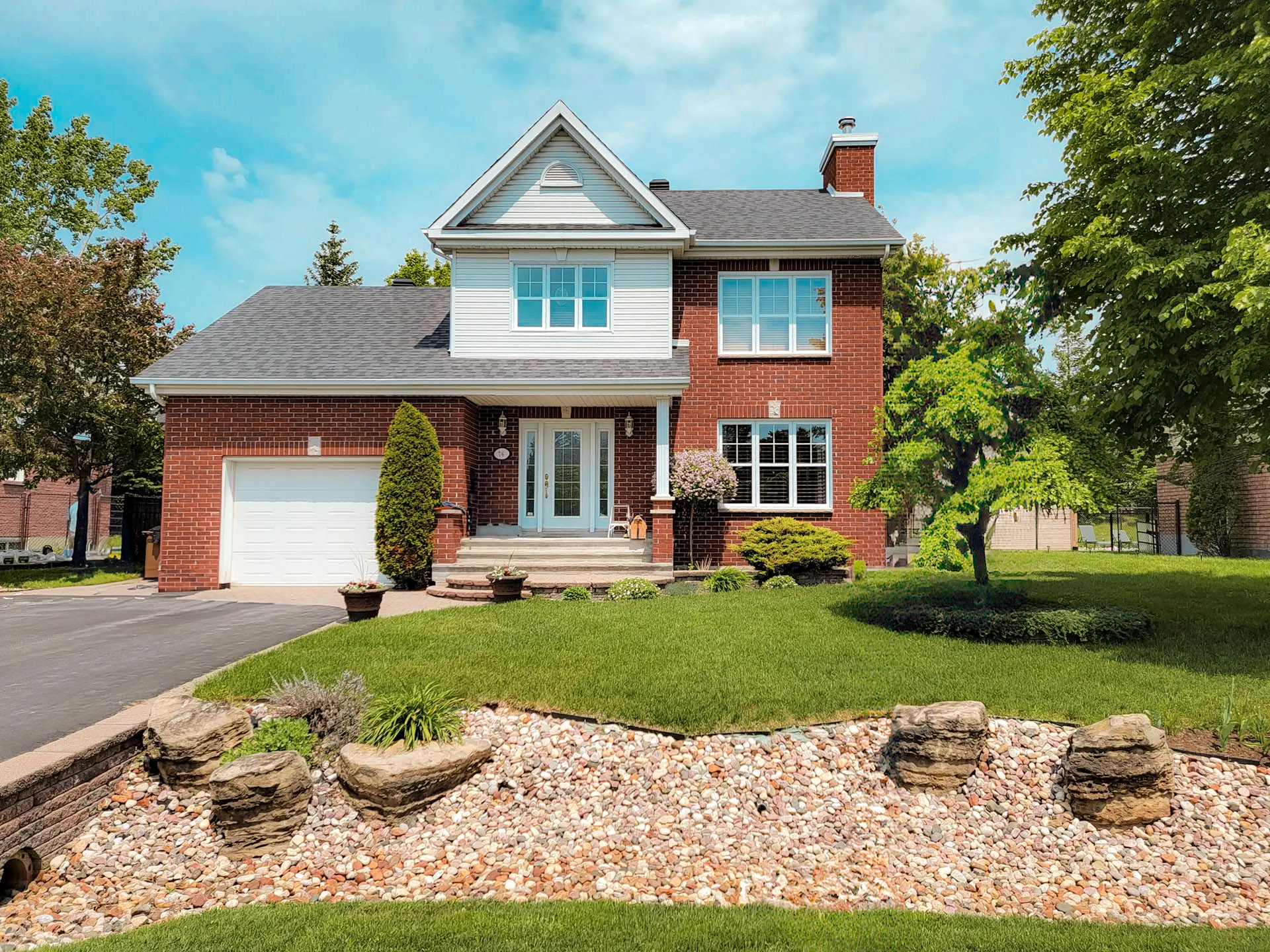
Source : Rénovations MTR inc.
Regularly maintaining your exterior siding is essential to prolong its lifespan and upkeep the look of your home. Different materials call for different, unique maintenance methods, and understanding the needs of each siding type is crucial to prevent damage and uphold quality.
Siding-Specific Maintenance Methods
Wood
Wood siding calls for meticulous care given the material’s sensitivity to moisture and insects. To maintain its appearance and durability, applying a new coat of paint or stain every 3 to 5 years is recommended, depending on weather exposure. Wood must be regularly inspected to ascertain any signs of rotting or insect infestation, and damaged areas must be treated immediately to prevent proliferation.
Vinyl
Vinyl siding is relatively easy to maintain. Simply clean it once or twice a year with water and a gentle detergent to eliminate dirt, mould, and algae. Avoid using pressure washers up close as it might damage the vinyl or cause water to seep behind the siding. In case of UV-caused fading, dedicated products can be used to restore the material.
CanExel
CanExel siding calls for a similar maintenance routine as wood. A yearly cleaning with soapy water is plenty to upkeep the product’s appearance. Like wood, it’s essential to watch out for mould or fungi growth and treat any surface damage promptly to prevent any costly repairs over time.
Fibre Cement Panels
Fibre cement is a low-maintenance, robust material, but it still requires regular inspection to spot any cracks or chips. Washing it occasionally using water and a gentle detergent is plenty to upkeep the product’s appearance. The joints should be checked to prevent water intrusion. If the paint appears to be chipping or fading, a fresh coat of paint after a few years might be in the cards.
Aluminum
Aluminum siding is low maintenance. It’s rust-resistant, but scratches can leave the metal underlay exposed to corrosion, especially in coastal areas. Regular cleaning using water and a gentle detergent is recommended to remove dirt and prevent stains. Also, check the fasteners and joints to make sure they’re still properly sealed and waterproof.
Stone
Stone veneer is low maintenance, but must be regularly inspected to spot any cracks or deteriorating joints. Washing the product occasionally with water and a gentle brush is recommended to remove dirt and moss. The joints should be redone when needed to prevent water intrusion that could damage the underlying structure.
Brick
Brick cladding is durable and low maintenance, but keeping an eye on the mortar joints to spot any signs of deterioration is paramount. A yearly cleaning with water and a gentle brush typically suffices to eliminate dirt deposits. If cracks surface, repair them promptly to prevent water from leaking in and causing structural damage.
Common Repairs and Preventative Maintenance
Wear-Related Red Flags
It’s important to regularly check the state of your exterior siding to spot any signs of wear. For wood, look for rotting or insect infestation. For vinyl, fading and cracking may be indicative of a need for repairs. Cracks in fibre cement, aluminum, and brick joints must also be monitored and treated promptly to prevent further damage.
How to Repair Minor Damage
Small repairs can often be done by the homeowner. For example, cracks in wood siding can be filled with some wood filler and then painted to blend with the rest of the cladding. Damaged areas on vinyl can be replaced without having to replace all the siding. As for fibre cement and aluminum, chips and scratches can be repaired with dedicated products sold in hardware stores. It’s essential to treat minor issues promptly to prevent costly repairs down the line.
When should exterior siding be replaced?
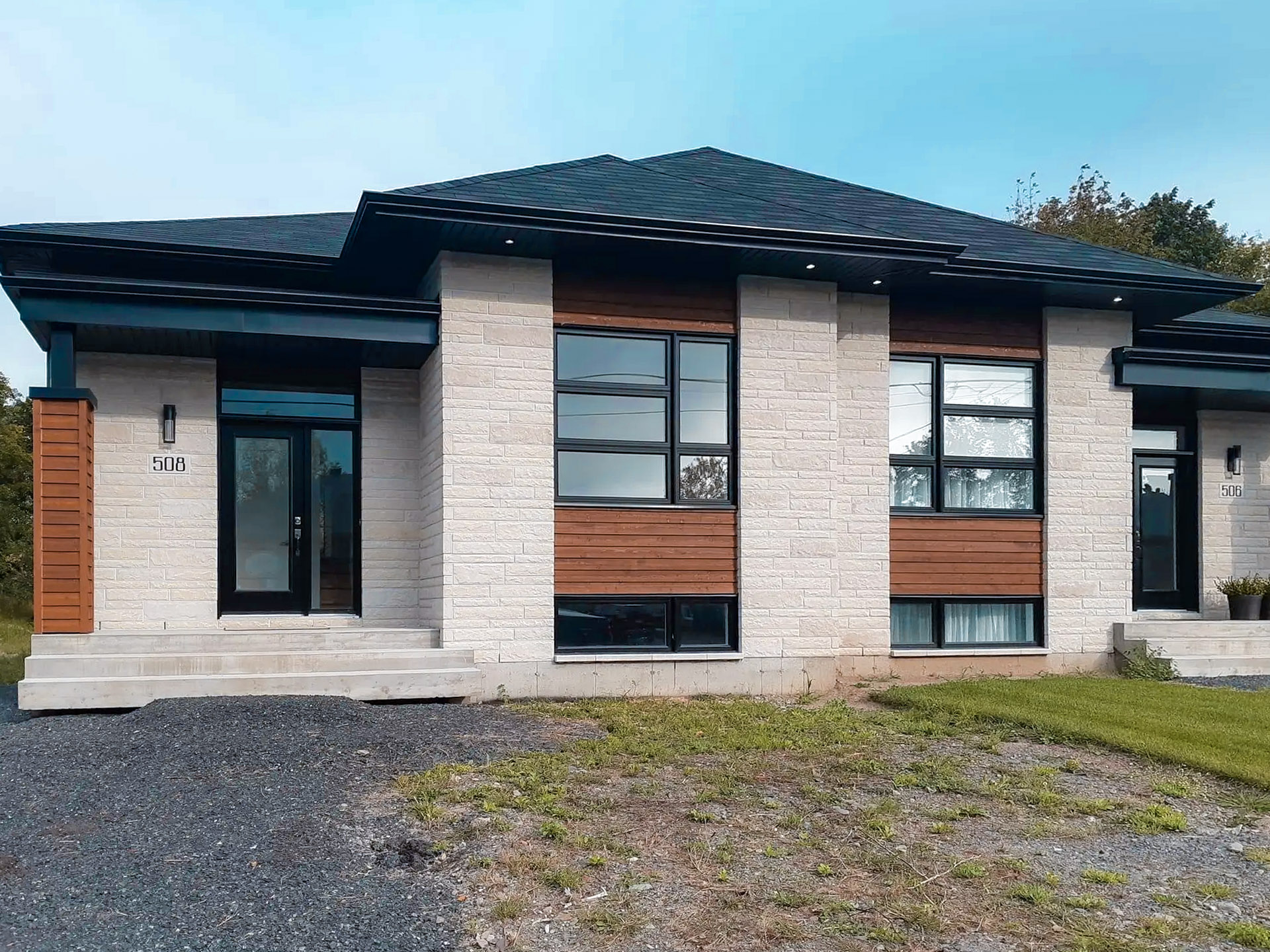
Source : Construction JB Inc.
Replacing the exterior siding flanking the sides of your house is an important decision that can’t be taken lightly; several factors must be considered, such as visible wear, material age, and insulation efficiency. Determining the ideal time to proceed with renovation work allows you to bypass major issues and preserve the value of your property.
Renovation Determining Factors
Recommended Maintenance Schedule
The maintenance schedule depends on the type of siding installed. For example, wood siding calls for regular maintenance, with paint or stain application every 3 to 5 years. On the other hand, materials like vinyl or fibre cement call for less upkeep, but yearly inspections are still recommended to spot any signs of wear. Proceeding with renovation work can be considered if maintenance proves to be too costly and often.
Material Lifespan
Every material has a unique lifespan. Wood, if well maintained, lasts 20 and 40 years, whereas vinyl and aluminum can surpass a 40-year lifespan. Fibre cement has a similar longevity, often around 40 to 50 years. However, signs of deterioration prior to said period can be indicative of a necessary renovation. If your siding has surpassed its expected lifespan, it may be time to replace it to prevent structural problems.
When is the best time to renovate your exterior siding?
The ideal time to carry out exterior siding renovations depends on several weather-related factors. Summer is often the preferred season for renovations on account of more stable weather patterns, which allows for continuous work efforts and easier material installation. Spring and fall are also good periods, offering moderate temperatures and streamlining work efforts, especially for products like fibre cement and aluminum, which are both sensitive to harsh weather. Winter is typically avoided, aside from urgent work.
Telltale Signs of a Much-Needed Renovation
Clear Signs of Wear
Visible wearing is a sure sign to upgrade your siding. Warning signs can include fading, cracks, or sections of the siding coming loose. For wood siding, wear and tear can manifest as peeling or chipping paint or rotting wood. For materials like vinyl or fibre cement, cracking or warping can indicate that the material is no longer fulfilling its protective function.
Water Intrusion
Water intrusion is a serious problem that can cause significant structural damage to your home. If you notice moisture stains inside your house, or if you spot signs of mould on the exterior walls, it may be indicative that your siding is no longer waterproof and in dire need of replacing. Overlooking these signs may lead to much higher repair costs in the long run.
Insulation Problems
Insulation problems can also indicate that your siding needs replacing. Suppose you start noticing that your house is harder to heat or cool, or your energy bills are skyrocketing for no apparent reason. This may be indicative that your exterior siding no longer provides adequate insulation. In that case, renovating becomes mandatory to improve your home’s energy efficiency and reduce long-term expenses.
Protect Your Home with Exterior Siding
Updating or maintaining your exterior siding is essential to guarantee your home's longevity, appearance, and energy efficiency. By selecting the right material and carrying out regular maintenance, you’re protecting your property from adverse weather and future expensive repairs. Look out for signs of wear and plan your renovations at the right time to maximize your siding’s durability.
Overall, properly overseeing your exterior siding contributes to your home’s safeguarding and improves its value over time.
FAQ
Can white vinyl siding be rejuvenated?
Yes, white vinyl siding can be rejuvenated by thoroughly cleaning it with a vinegar and water solution to remove dirt, mould, and oxidation, then applying a specialized vinyl siding restorer, which revives the original colour and luster and can protect the siding for years.
Looking for something else?
Related articles
The latest industry news, interviews, technologies, and resources.

Editorial Team
•18 Apr 2025
Does stucco still have a place in renovations? How should it be maintained and repaired? Can it be used indoors? Once very popular, this textured coating seems to be making a comeback, particularly due to its insulating and aesthetic qualities. However, it also raises questions: how should it be properly applied? What are its advantages and limitations? And most importantly, how can it be maintained to ensure its longevity?

Editorial Team
•02 Oct 2024
Are you hoping to install new exterior siding on your house or update the existing material? Exterior wood siding is surely the best option as wood is a natural insulator, durable, and aesthetically pleasing.
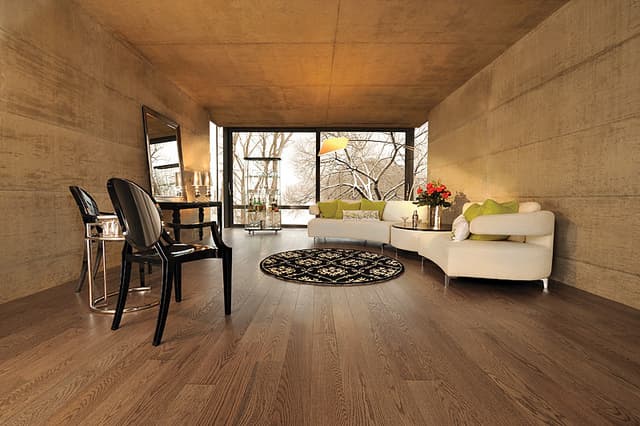
Léa Plourde-Archer
•07 Nov 2023
Deciding to replace your current floor is a process that should not be taken lightly. Not only is it a major financial investment, but it also takes time. Which material is best? Which colour?

Editorial Team
•15 Dec 2023
Floors are made up of several layers. Beyond the walking surface, meaning the flooring, the strength and durability of the floor rely on the structure of the house, joists, subfloor, and underlayment. When building or renovating a floor, you have to think about each of these layers, as they play a much more important role than one may know.

Amanda Harvey
•22 Apr 2024
Classic style doesn’t have to mean being outdated or entering into a traditional time warp. Although this style is rooted in tradition, classic home decor incorporates fine architectural details with sophistication. It enlivens the timeless elements of the past while remaining contemporary and in touch with current trends.